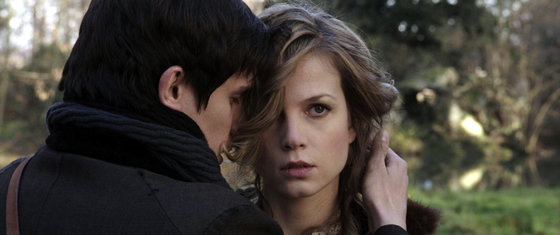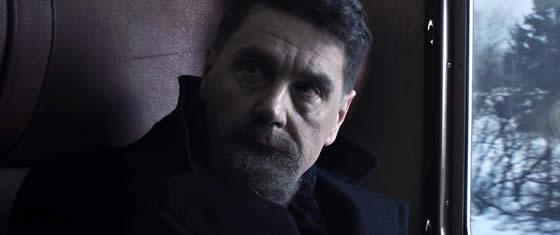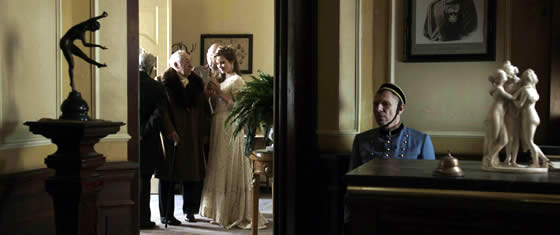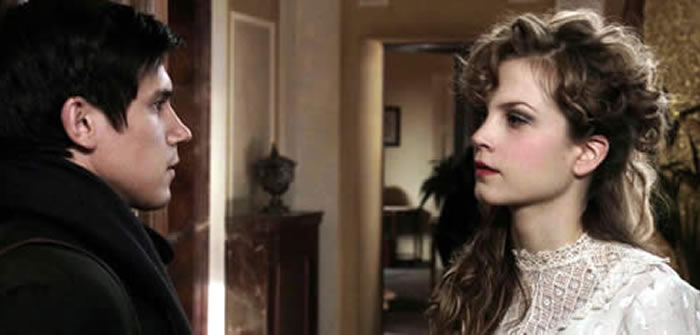 THE GIRL AND DEATH, Winner of Best Picture at the Netherlands Film Festival, is the latest film from Jos Stelling (THE POINTSMAN, THE ILLUSIONIST, THE FLYING DUTCHMAN).
THE GIRL AND DEATH, Winner of Best Picture at the Netherlands Film Festival, is the latest film from Jos Stelling (THE POINTSMAN, THE ILLUSIONIST, THE FLYING DUTCHMAN).
THE GIRL AND DEATH is a story about the impossible love between Nicolai and the courtesan Elise; a love that is obstructed by materialism, wealth, and the threat of death. In Russia of the post-WWII era, aging doctor Nicolai returns to an old, abandoned hotel, the place where he first met his great love 50 years ago, and relives his romantic tragedy, a tragedy that happens in the late nineteenth century, and embodies the end of an era and the vibrant hopes and life of both its young couple and of a new world. The hotel still bears the traces of its impressive past. Eventually, it becomes clear why Nicolai has really returned… As ever, Stelling’s unique cinema is based on idiosyncratic humor, stunning images and large emotions. This is a film about time that seems to exist miraculously outside of time…
Bijan Tehrani: How did you come up with the idea of THE GIRL AND DEATH?
Jos Stelling: I wanted to make a film about melancholia. I’m very drawn to the late 19th century Russian romantic culture, which is rich in its melancholia and dreamy visualizations. Above all, I wanted to make a film that is, in my view, visual art as an answer to the fast-moving storytelling made by small digital cameras. To me, cinema is all about visual poetry. I wanted to make a film in which the images tell the story and make the audience feel the story. I believe film is firstly a spectacle for the eyes. Cinema goes directly via the eyes to the heart, and I believe a film is only half of the whole experience; the other half is being determined by the people that see it. The better the audience, the better the film.
the eyes. Cinema goes directly via the eyes to the heart, and I believe a film is only half of the whole experience; the other half is being determined by the people that see it. The better the audience, the better the film.
Another reason was that I saw a film, the most beautiful film that I ever saw, when I was 9 years old and it was in the early 50s. It was a German film and I watched the film 9 or 10 times and I cried and cried. It was about an operetta singer in the 1930s and the name of the film was ‘Du bist die Welt fïr mich ((The Richard Tauber Story)’. A journalist asked me what was my favorite film and I did not want to say because it was this little strange German film. When I saw it again 10 years ago, the dream was shattered, there wasn’t much left of it, it was a badly made film. That’s often the way with first loves. Maybe The Girl and Death is an attempt to keep my old dream alive. So that was a very melancholic starting point. I was also inspired by Russian literature and Russian culture and Russian actors. Sylvia Hoeks was also a great inspiration. I realized while making Duska that she is a fascinating film actress with a lot of great qualities. I did not use her full potential so much in that film and I promised myself to work with her again in a main role.
BT: When I was watching THE GIRL AND DEATH, I felt that there were romantic elements; your film was almost like Dostoyevsky in motion.
JS: That is also my opinion about film in general: it is not the characters that are telling the story, but the space in between the characters—the situations are telling the story. I don’t think that audiences believe that they are involved in the actors and the characters, my opinion is that they are involved in the situations, and so I keep the characters silent to give the invitation of space and give the audience more possibilities to be involved. That is my general opinion about film; I don’t believe that the characters are so important. For example, when there is a duck walking on the street, there is nothing happening. But when you are seeing another duck with a knife around the corner, then the first duck becomes more interesting, and it is only the situation that is telling the story, not the actors. Sometimes they will say that they first  duck is a good actor, but it is only the situation. Film reveals the magnetic field between all kinds of opponents. It’s not so much about the characters, but more about the magnetic field between them.
duck is a good actor, but it is only the situation. Film reveals the magnetic field between all kinds of opponents. It’s not so much about the characters, but more about the magnetic field between them.
BT: How did you come up with the visual style of your film?
JS: I have been working with the same crew—my cameraman, my art director and my editor—for more than 30 years. We are a group of friends and we know each other very well. The reason I make films in general is because they allow me to do more than I can do by myself. I enjoy the process, but also working with people who are better than me and giving them direction in the film so they can help me create; that is the idea of the film.
BT: Casting is very important because I could not see THE GIRL AND DEATH with any other actors than the ones you casted. How did you go about casting the film?
JS: The older Russian actor is a friend of mine, and the others are friends as well. When a script is evolving, there is a certain moment when you realize that you need actors. Not exactly when the script is finished, but during its creation and build-up you need actors for evolving. I talked with them and they agreed to offer their own, and then the script is finished with actors in mind. I think this is why the actors seem to fit so well to the story.
BT: How did you work with the actors? Did you rehearse a lot or did you encourage improvisation?
JS: We rehearsed a lot, but there was also a lot of talking and trusting each other. Russian actors are very disciplined; they have all started in theater and they are now going into film, and they work for companies in the west. The education of an actor in Russia is very tough because they have to be able to do everything. They have to sing and dance, and it is a very hard profession, so working with these people is a pleasure. I had met with Nikolai a year before shooting, and he rehearsed with magicians and worked hard to prepare for the card scene in the film. He did all of the tricks himself. They are extraordinary people, my actors.
BT: At a time where you don’t see many pure romantic films about love, your film comes out and it separates itself from many films in Western cinema, so your film is an exceptional.
JS: Thank you. I talked about the space in-between the actors and creating a scene, and that’s what Hollywood can be missing sometimes. You can’t just make film about love; you need a woman and a man, a day and a night, the future, the past, and something in between.
BT: Do you think THE GIRL AND DEATH will get a theatrical release in the United States?
JS: They are showing it in Europe and Russia, currently. I am more famous in Russia than in Holland. I am curious about what will happen in Los Angles and New York, and I hope people will enjoy the film even though it is not a mainstream one.

